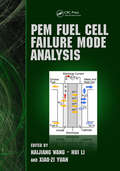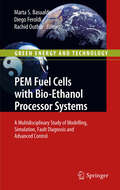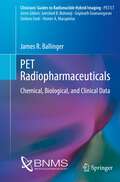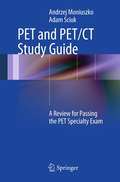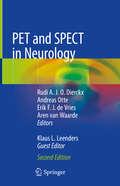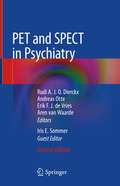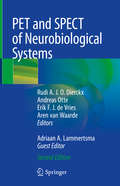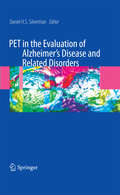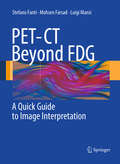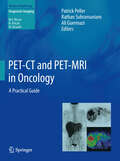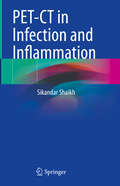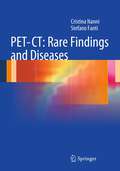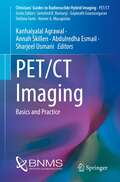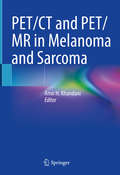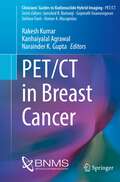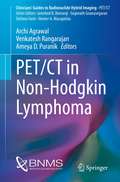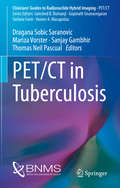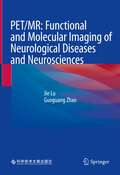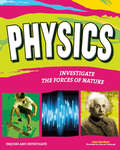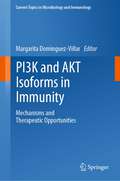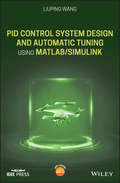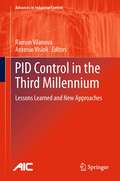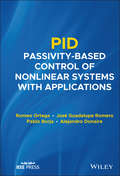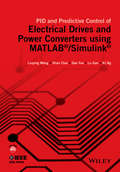- Table View
- List View
PEM Fuel Cell Failure Mode Analysis
by Hui Li Haijiang Wang Xiao-Zi YuanPEM Fuel Cell Failure Mode Analysis presents a systematic analysis of PEM fuel cell durability and failure modes. It provides readers with a fundamental understanding of insufficient fuel cell durability, identification of failure modes and failure mechanisms of PEM fuel cells, fuel cell component degradation testing, and mitigation strategies agai
PEM Fuel Cells with Bio-Ethanol Processor Systems
by Rachid Outbib Diego Feroldi Marta S. BasualdoAn apparently appropriate control scheme for PEM fuel cells may actually lead to an inoperable plant when it is connected to other unit operations in a process with recycle streams and energy integration. PEM Fuel Cells with Bio-Ethanol Processor Systems presents a control system design that provides basic regulation of the hydrogen production process with PEM fuel cells. It then goes on to construct a fault diagnosis system to improve plant safety above this control structure. PEM Fuel Cells with Bio-Ethanol Processor Systems is divided into two parts: the first covers fuel cells and the second discusses plants for hydrogen production from bio-ethanol to feed PEM fuel cells. Both parts give detailed analyses of modeling, simulation, advanced control, and fault diagnosis. They give an extensive, in-depth discussion of the problems that can occur in fuel cell systems and propose a way to control these systems through advanced control algorithms. A significant part of the book is also given over to computer-aided engineering software tools that can be used to evaluate the dynamic performance of the overall plant. PEM Fuel Cells with Bio-Ethanol Processor Systems is intended for use by researchers and advanced students on chemical, electrical-electronic and mechanical engineering courses in which dynamics and control are incorporated with the traditional steady-state coverage of flowsheet synthesis, engineering economics and optimization.
PET Radiopharmaceuticals: Chemical, Biological, and Clinical Data (Clinicians’ Guides to Radionuclide Hybrid Imaging)
by James R. BallingerThis book presents in a consistent format data on ~50 PET radiopharmaceuticals in clinical use. Parameters include basic chemical data, normal biodistribution and excretion, activity administered, radiation dosimetry, patient preparation, and clinical utility, together with a few key references. In some cases a representative image is presented. The organisation is first by clinical specialty (oncology, cardiology, neurology) and within each section by radionuclide (F-18, C-11, etc). This book will be of interest mostly to nuclear medicine physicians and trainees, but also to a wider medical community including radiologists, oncologists and radiotherapists.
PET and PET/CT Study Guide
by Andrzej Moniuszko Adam SciukThe PET and PET/CT Study Guide presents a comprehensive review of nuclear medicine principles and concepts necessary for passing PET specialty board examinations. The practice questions and content are similar to those found on the Nuclear Medicine Technology Certification Board (NMTCB) exam, allowing test takers to maximize their chances of success. The book is organized by test sections of increasing difficulty, with over 650 multiple-choice questions covering all areas of positron emission tomography, including radiation safety; radionuclides; instrumentation and quality control; patient care; and diagnostic and therapeutic procedures. Detailed answers and explanations to the practice questions follow. Supplementary appendices include common formulas, numbers, and abbreviations, along with a glossary of terms for easy access by readers. The PET and PET/CT Study Guide is a valuable reference for nuclear medicine technologists, nuclear medicine physicians, and all other imaging professionals in need of a concise review of the basics of PET and PET/CT imaging.
PET and SPECT in Neurology
by Andreas Otte Erik F. J. de Vries Rudi A. J. O. Dierckx Klaus L. Leenders Aren Van WaardeThis book provides a comprehensive overview of the use of PET and SPECT in not only classic neurodegenerative disorders but also cerebrovascular disorders, brain tumors, epilepsy, head trauma, coma, sleeping disorders, and inflammatory and infectious diseases of the CNS. The new edition has been revised and updated to reflect recent advances and includes additional chapters, for example on the use of artificial intelligence and machine learning in imaging data analysis, the study of brain connectivity using PET and SPECT images, and the role of PET imaging in modulation of brain functioning by deep brain stimulation. The authors are renowned experts whose dedication to the investigation of neurological disorders through nuclear medicine technology has achieved international recognition. Most chapters are written jointly by a clinical neurologist and a nuclear medicine specialist to ensure a multidisciplinary approach. This state of the art compendium will be invaluable for neurologists and radiologists/nuclear medicine specialists and will also be informative for interested general practitioners and geriatricians. Companion volumes on PET and SPECT in psychiatry and in neurobiological systems complete a trilogy.
PET and SPECT in Psychiatry
by Andreas Otte Erik F. J. de Vries Rudi A. J. O. Dierckx Aren Van Waarde Iris E. SommerThis book provides a comprehensive overview of the use of PET and SPECT in the classic psychiatric disorders such as depression, bipolar disorder, anxiety disorders, and schizophrenia. In addition, it discusses the application of these functional neuroimaging techniques in a variety of other conditions, including sleep disorders, eating disorders, autism, and chronic fatigue syndrome. The new edition has been extensively revised and updated to reflect the latest advances and results in nuclear imaging within the field. Most chapters are written jointly by a clinical psychiatrist and a nuclear medicine expert to ensure a multidisciplinary approach. This state of the art compendium will be of value for all who have an interest in the field of neuroscience, from psychiatrists and radiologists/nuclear medicine specialists to interested general practitioners and cognitive psychologists. Companion volumes on the use of PET and SPECT in neurology and for the imaging of neurobiological systems complete a trilogy.
PET and SPECT of Neurobiological Systems
by Andreas Otte Erik F. J. de Vries Rudi A. J. O. Dierckx Aren Van Waarde Adriaan A. LammertsmaThis book, now in a fully updated second edition, is a comprehensive and up-to-date guide to the use of PET and SPECT for the imaging of neurobiological systems. Diverse aspects of neurotransmission in the brain are discussed, such as visualization and quantification of neuroreceptors, neuroinflammatory markers, transporters, and enzymes as well as neurotransmitter synthesis, β-amyloid deposition, cerebral blood flow, and the metabolic rate of glucose. The latest results in probe development are also detailed. A wide range of systems not addressed in the first edition are covered, reflecting the advances made in recent years. The book combines the expertise of authors internationally renowned for their dedication to the development of novel probes and techniques for the investigation of neurobiological systems. Most chapters are written jointly by radiochemists and nuclear medicine specialists to ensure a multidisciplinary approach. This state of the art compendium will be valuable to all with an interest in clinical and preclinical neuroscience. Companion volumes on the use of PET and SPECT in neurology and psychiatry complete a trilogy.
PET in the Evaluation of Alzheimer's Disease and Related Disorders
by Dan SilvermanThis practical guide contains all the science and clinical information needed to help the reader make informed decisions about the applications of brain PET to improve the care of patients with symptoms of Alzheimer's disease and related disorders. Beginning with an introduction to goals and limitations of the clinical evaluation of dementia, Dr. Dan Silverman and his distinguished group of contributors cover the role of functional imaging, clinical interpretation of brain FDG-PET scans, FDG-PET in the evaluation of early dementia, microstructural imaging of neurodegenerative changes, amyloid imaging, imaging non-neurodegenerative causes of cognitive impairment, tools for assisting PET scan interpretation in the clinical setting, and PET evaluation of central motor disorders. There is also a complete collection of clinical cases that practitioners are likely to encounter in daily practice. Enhanced with numerous PET brain scans, this book fills a rapidly growing need in the medical imaging field.
PET-CT Beyond FDG
by Mohsen Farsad Stefano Fanti Luigi MansiAlthough [18F]fluorodeoxyglucose (FDG) generally shows an excellent performance as a cancer-imaging agent when using PET-CT, there are some settings in which other radiopharmaceuticals offer advantages. Such non-FDG tracers are now gaining widespread acceptance not only in research but also in clinical practice. This atlas, including about 500 high-quality images, is a user-friendly guide to PET-CT imaging beyond FDG. A wide range of tracers is covered, such as 18F- and 11C-choline, 11C-methionine, 18F-ethyl-L-tyrosine, 68Ga-DOTA-NOC, 11C-acetate, 11C-thymidine, and 18F-DOPA. Throughout, the emphasis is on image interpretation, with guidance on the recognition of normal, benign, and malignant uptake and clear instruction on learning points and pitfalls. This atlas is designed to serve as a reference text for both nuclear physicians and radiologists, and will also be of great benefit to radiographers, technologists, and nuclear medicine and radiology residents.
PET-CT and PET-MRI in Oncology
by Patrick Peller Rathan Subramaniam Ali GuermaziOver the past decade, PET-CT has achieved great success owing to its ability to simultaneously image structure and function, and show how the two are related. More recently, PET-MRI has also been developed, and it represents an exciting novel option that promises to have applications in oncology as well as neurology. The first part of this book discusses the basics of these dual-modality techniques, including the scanners themselves, radiotracers, scan performance, quantitation, and scan interpretation. As a result, the reader will learn how to perform the techniques to maximum benefit. The second part of the book then presents in detail the PET-CT and PET-MRI findings in cancers of the different body systems. The final two chapters address the use of PET/CT in radiotherapy planning and examine areas of controversy. The authors are world-renowned experts from North America, Europe, and Australia, and the lucid text is complemented by numerous high-quality illustrations.
PET-CT in Infection and Inflammation
by Sikandar ShaikhThis book covers all aspects of PET-CT including newer applications involving infection and inflammation and basic information on PET-CT new tracers. It explains the approach, protocols and miscellaneous applications about various infections and inflammation that helps in its early and better diagnosis in multiorgan and multisystem involvements in routine clinical practice.Chapters provide systematic approach to the diagnosis of various infections such as bacterial, viral, tuberculosis, inflammatory pathologies and overlap in coexisting tumors and superadded/associated infections. This book offers assistance to medical practitioners in understanding various advantages of PET-CT in single scan as compared to different modalities for diagnosis as well as oncologists dealing with concurrent malignant and non-malignant conditions, students, and interns.
PET-CT: Rare Findings and Diseases
by Stefano Fanti Cristina NanniPET-CT is increasingly being employed in the diagnosis of both oncological and non-oncological patients, yet nuclear medicine physicians may have only limited practical experience of rare diseases and may experience difficulty in recognizing and interpreting rare findings. This unique atlas documents a large number of clinical cases that will help practitioners to identify findings and diseases that, though rare, are sufficiently frequent to be encountered in routine practice. Two types of cases are presented: patients evaluated for rare diseases and patients evaluated for standard diseases in whom atypical PET findings were detected. Each reported case includes a brief description of the clinical history, representative color PET-CT images obtained using FDG or other tracers, and a short explanation of the disease and findings. This atlas will enable practitioners to make conclusive reports of PET-CT scans that would otherwise have been inconclusive.
PET/CT Imaging: Basics and Practice (Clinicians’ Guides to Radionuclide Hybrid Imaging)
by Kanhaiyalal Agrawal Annah Skillen Abdulredha Esmail Sharjeel UsmaniThe aim of this book is to provide concise information and quick reference on the basics and practice of PET/CT for beginners. The chapters are written by Nuclear Medicine experts from different countries with enormous experience in PET/CT practice. Starting with the basics of PET/CT describing physics and the use of radiopharmaceuticals in PET/CT, the book explores the principle of PET/CT in radiotherapy planning. The last five chapters explore normal variation, pitfalls and artefacts commonly seen with various routinely used PET radiotracers. The text is enriched by tables and highlighted clinical cases for better understanding. This book will be of interest mostly to nuclear medicine physicians and radiologists, but it may be appealing also to a wider medical community including oncologists and radiotherapists.
PET/CT and PET/MR in Melanoma and Sarcoma
by Amir H. KhandaniThis is a comprehensive guide for patient preparation, image acquisition, and image interpretation for PET/CT and PET/MR, specifically relevant to melanoma and sarcoma. Imaging specialists and referring physicians are often not as intimately aware of the particulars of PET imaging in management of patients with melanoma and sarcoma and how it could affect their treatment. This book fills that gap by presenting comprehensive information on melanoma, sarcoma, and the role of PET imaging in their diagnosis and management. The book begins by covering the basics of imaging for practicing physicians and trainees. Expert authors then further cover the biological concepts of melanoma and sarcoma and how they relate to imaging, particularly PET, the oncologist’s perspective, and the surgeon’s perspective on imaging for both the imaging specialist and the referring physician. Chapters review topics such as: PET/CT and PET/MR images in melanoma and sarcoma from a systemic approach, false-positives, false-negatives, pitfalls, and molecular imaging beyond PET. Images are used extensively throughout to enhance understanding for the reader. This is an ideal guide for radiologists, nuclear medicine physicians, oncologists, surgeons, trainees and technologists.
PET/CT in Breast Cancer (Clinicians’ Guides to Radionuclide Hybrid Imaging)
by Rakesh Kumar Kanhaiyalal Agrawal Narainder K. GuptaThe aim of this book is to provide crisp information related to pathology, management and radiological/molecular imaging in breast carcinoma, along with detailed information on FDG PET-CT in breast cancer, normal variants, artefacts, pitfalls with atlas illustrations. The book is unique in providing quick reference to practice of PET/CT in breast cancer. The initial few chapters are related to the pathology and management of breast carcinoma to help understand the pathophysiology of breast cancer before going to the imaging. The chapter on imaging in breast cancer highlights the role of different imaging modalities for different indications to the reader. The last four chapters describe in detail the role, normal variants, artefacts and pitfalls of FDG PET/CT along with recent molecular imaging advances in breast cancer.Written by Pathology, Oncology, Radiology and Nuclear Medicine experts from different countries with enormous experience in breast cancer practice, the book addresses nuclear medicine physicians and radiologists, but it may be of interest to a wider medical community, including oncologists and radiotherapists.
PET/CT in Non-Hodgkin Lymphoma (Clinicians’ Guides to Radionuclide Hybrid Imaging)
by Archi Agrawal Venkatesh Rangarajan Ameya D. PuranikThis book provides an up-to-date summary of the latest scientific developments on the use of PET-CT imaging in Non-Hodgkin Lymphoma (NHL). It encompasses the entire spectrum of NHL – from pathology to radiological and PET-CT imaging and to the management of NHL. The highlight of the book is the excellent pictorial depiction of normal variants, pitfalls and artifacts while exploring the different types of NHL and its manifestations. Each chapter, written by well-known and experienced oncologists and physicians, is enriched by a wide range of images to ensure a clear concept of PET-CT imaging in NHL and will definitely keep the readers interested.This book will be a useful tool for nuclear physicians, radiologists, referring clinicians and oncologists, as well as para-medical staff working in this field.
PET/CT in Tuberculosis (Clinicians’ Guides to Radionuclide Hybrid Imaging)
by Dragana Sobic Saranovic Mariza Vorster Sanjay Gambhir Thomas Neil PascualThis book covers both the science of PET/CT imaging in tuberculosis and the impact that this technique can have on disease management through the provision of high-quality evidence regarding function and structure. The scientific principles of PET/CT, the radiopharmaceuticals used in the context of tuberculosis (FDG and non-FDG tracers), patient preparation, and imaging protocols are fully explained. Imaging findings obtained in different settings, including pulmonary and extrapulmonary tuberculosis, tuberculosis and HIV co-infection, and evaluation of response to antituberculous therapy, are described with the aid of many high-quality illustrations. Attention is drawn to mimics of tuberculosis, pitfalls, and limitations. The book will be an excellent asset for referring clinicians, nuclear medicine/radiology physicians, radiographers/technologists, and nurses who routinely work in nuclear medicine and participate in multidisciplinary meetings.
PET/MR: Functional and Molecular Imaging of Neurological Diseases and Neurosciences
by Jie Lu Guoguang ZhaoThis book aims to summarize the research progress of integrated PET/MR brain function and molecular imaging, and more importantly, clinical application and research status of PET/MR of brain imaging from brain diseases to brain science. Starting from the overviews of brain function imaging technology, following chapters introduces clinical application of integrated PET/MR specific brain diseases in details, such as Alzheimer's disease, Parkinson's disease, epilepsy, and brain tumor, etc., which are hot issues of brain science research. It will be a useful reference to residents and practitioners in nuclear medicine, radiology, and neurology, as well as those interested in molecular imaging of brain.
PHYSICS
by Jane P. Gardner Samuel CarbaughHave you ever noticed that the physical world works in certain ways? When you push an object it moves. Skateboarders use force and motion to perform tricks. If you jump up as high as you can, you'll quickly fall back to the ground. Baseball players use gravity to bring the ball back down when they throw it. When you flip a switch, electricity powers your toaster. Rock bands use electricity to put on a show. The fascinating science of physics helps you understand why forces, motion, gravity, electricity, light, and sound work in predictable ways.Combining inquiry-based, age-appropriate activities with physics topics, Physics: Investigate the Forces of Nature features graphic novel illustrations, fascinating sidebars, youtube links, and a glossary of important vocabulary to illuminate the complex world of physics and bring it to life. Projects include designing a skateboard park that maps the forces at work on the skateboarder and the skateboard, arguing your way out of a speeding ticket using the properties of physics, and creating a stage design for a rock band that places electric current where it is needed. Additional materials include a list of current reference works, websites, and Internet resources.
PI3K and AKT Isoforms in Immunity: Mechanisms and Therapeutic Opportunities (Current Topics in Microbiology and Immunology #436)
by Margarita Dominguez-VillarThis book provides an essential overview of the role of phosphoinositide-3-phosphate kinase (PI3K) isoforms in modulating the function of immune system cells and their involvement in disease.PI3K is a family of kinases involved in basic cellular processes such as proliferation, migration and cell death. Recent work has highlighted the multiple roles of PI3K classes and subunits and their involvement in the immune response to the body’s own and foreign antigens and diseases such as cancer and autoimmunity. This book offers a detailed introduction to the biology of the three PI3K classes, followed by an extensive discussion of the diverse roles of AKT and PI3K isoforms in immune cells. Based on this knowledge, it subsequently explains in more detail how specific isoforms are connected to immune-mediated diseases. The book concludes by highlighting the latest advances in the production of isoform-specific inhibitors and their use in various human diseases. This book is intended as a reference guide for students and researchers interested in the multifaceted aspects of PI3K biology.
PICTURING QUANTUM PROCESSES: A First Course in Quantum Theory and Diagrammatic Reasoning
by Bob Coecke Aleks KissingerThe unique features of the quantum world are explained in this book through the language of diagrams, setting out an innovative visual method for presenting complex theories. Requiring only basic mathematical literacy, this book employs a unique formalism that builds an intuitive understanding of quantum features while eliminating the need for complex calculations. This entirely diagrammatic presentation of quantum theory represents the culmination of ten years of research, uniting classical techniques in linear algebra and Hilbert spaces with cutting-edge developments in quantum computation and foundations. Written in an entertaining and user-friendly style and including more than one hundred exercises, this book is an ideal first course in quantum theory, foundations, and computation for students from undergraduate to PhD level, as well as an opportunity for researchers from a broad range of fields, from physics to biology, linguistics, and cognitive science, to discover a new set of tools for studying processes and interaction.
PID Control System Design and Automatic Tuning using MATLAB/Simulink (Wiley - IEEE)
by Liuping WangCovers PID control systems from the very basics to the advanced topics This book covers the design, implementation and automatic tuning of PID control systems with operational constraints. It provides students, researchers, and industrial practitioners with everything they need to know about PID control systems—from classical tuning rules and model-based design to constraints, automatic tuning, cascade control, and gain scheduled control. PID Control System Design and Automatic Tuning using MATLAB/Simulink introduces PID control system structures, sensitivity analysis, PID control design, implementation with constraints, disturbance observer-based PID control, gain scheduled PID control systems, cascade PID control systems, PID control design for complex systems, automatic tuning and applications of PID control to unmanned aerial vehicles. It also presents resonant control systems relevant to many engineering applications. The implementation of PID control and resonant control highlights how to deal with operational constraints. Provides unique coverage of PID Control of unmanned aerial vehicles (UAVs), including mathematical models of multi-rotor UAVs, control strategies of UAVs, and automatic tuning of PID controllers for UAVs Provides detailed descriptions of automatic tuning of PID control systems, including relay feedback control systems, frequency response estimation, Monte-Carlo simulation studies, PID controller design using frequency domain information, and MATLAB/Simulink simulation and implementation programs for automatic tuning Includes 15 MATLAB/Simulink tutorials, in a step-by-step manner, to illustrate the design, simulation, implementation and automatic tuning of PID control systems Assists lecturers, teaching assistants, students, and other readers to learn PID control with constraints and apply the control theory to various areas. Accompanying website includes lecture slides and MATLAB/ Simulink programs PID Control System Design and Automatic Tuning using MATLAB/Simulink is intended for undergraduate electrical, chemical, mechanical, and aerospace engineering students, and will greatly benefit postgraduate students, researchers, and industrial personnel who work with control systems and their applications.
PID Control in the Third Millennium
by Antonio Visioli Ramon VilanovaThe early 21st century has seen a renewed interest in research in the widely-adopted proportional-integral-differential (PID) form of control. PID Control in the Third Millennium provides an overview of the advances made as a result. Featuring: new approaches for controller tuning; control structures and configurations for more efficient control; practical issues in PID implementation; and non-standard approaches to PID including fractional-order, event-based, nonlinear, data-driven and predictive control; the nearly twenty chapters provide a state-of-the-art resumé of PID controller theory, design and realization. Each chapter has specialist authorship and ideas clearly characterized from both academic and industrial viewpoints. PID Control in the Third Millennium is of interest to academics requiring a reference for the current state of PID-related research and a stimulus for further inquiry. Industrial practitioners and manufacturers of control systems with application problems relating to PID will find this to be a practical source of appropriate and advanced solutions.
PID Passivity-Based Control of Nonlinear Systems with Applications
by Romeo Ortega Jose Guadalupe Romero Pablo Borja Alejandro DonaireExplore the foundational and advanced subjects associated with proportional-integral-derivative controllers from leading authors in the field In PID Passivity-Based Control of Nonlinear Systems with Applications, expert researchers and authors Drs. Romeo Ortega, Jose Guadalupe Romero, Pablo Borja, and Alejandro Donaire deliver a comprehensive and detailed discussion of the most crucial and relevant concepts in the analysis and design of proportional-integral-derivative controllers using passivity techniques. The accomplished authors present a formal treatment of the recent research in the area and offer readers practical applications of the developed methods to physical systems, including electrical, mechanical, electromechanical, power electronics, and process control. The book offers the material with minimal mathematical background, making it relevant to a wide audience. Familiarity with the theoretical tools reported in the control systems literature is not necessary to understand the concepts contained within. You’ll learn about a wide range of concepts, including disturbance rejection via PID control, PID control of mechanical systems, and Lyapunov stability of PID controllers. Readers will also benefit from the inclusion of: A thorough introduction to a class of physical systems described in the port-Hamiltonian form and a presentation of the systematic procedures to design PID-PBC for them An exploration of the applications to electrical, electromechanical, and process control systems of Lyapunov stability of PID controllers Practical discussions of the regulation and tracking of bilinear systems via PID control and their application to power electronics and thermal process control A concise treatment of the characterization of passive outputs, incremental models, and Port Hamiltonian and Euler-Lagrange systems Perfect for senior undergraduate and graduate students studying control systems, PID Passivity-Based Control will also earn a place in the libraries of engineers who practice in this area and seek a one-stop and fully updated reference on the subject.
PID and Predictive Control of Electrical Drives and Power Converters using MATLAB / Simulink
by Liuping Wang Shan Chai Dae Yoo Lu Gan Ki NgA timely introduction to current research on PID and predictive control by one of the leading authors on the subject PID and Predictive Control of Electric Drives and Power Supplies using MATLAB/Simulink examines the classical control system strategies, such as PID control, feed-forward control and cascade control, which are widely used in current practice. The authors share their experiences in actual design and implementation of the control systems on laboratory test-beds, taking the reader from the fundamentals through to more sophisticated design and analysis. The book contains sections on closed-loop performance analysis in both frequency domain and time domain, presented to help the designer in selection of controller parameters and validation of the control system. Continuous-time model predictive control systems are designed for the drives and power supplies, and operational constraints are imposed in the design. Discrete-time model predictive control systems are designed based on the discretization of the physical models, which will appeal to readers who are more familiar with sampled-data control system. Soft sensors and observers will be discussed for low cost implementation. Resonant control of the electric drives and power supply will be discussed to deal with the problems of bias in sensors and unbalanced three phase AC currents. Brings together both classical control systems and predictive control systems in a logical style from introductory through to advanced levels Demonstrates how simulation and experimental results are used to support theoretical analysis and the proposed design algorithms MATLAB and Simulink tutorials are given in each chapter to show the readers how to take the theory to applications. Includes MATLAB and Simulink software using xPC Target for teaching purposes A companion website is available Researchers and industrial engineers; and graduate students on electrical engineering courses will find this a valuable resource.
